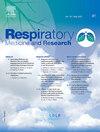老年人严重呼吸道合胞病毒感染——负担、临床结局和护理意义
IF 1.8
4区 医学
Q3 RESPIRATORY SYSTEM
引用次数: 0
摘要
成人呼吸道合胞病毒(RSV)感染的研究尚不充分。越来越多的检测正在揭示最普遍的下呼吸道感染中出现严重后果的新情况。了解危险因素变得越来越重要,特别是考虑到最近批准预防性疫苗接种。方法回顾性评价我院从2021年至2024年连续三个感染季节检测到的所有实时聚合酶链反应阳性的60岁及以上成人RSV病例。对需要住院治疗的严重感染患者的后续评估。结果共纳入574例,其中女性占57%,中位年龄81.1岁(IQR 74 ~ 87岁)。病例高峰发生在9月至3月。我们发现,在pcr确诊的RSV感染的老年人中,住院率为51.2%(代表我们地区老年人口每年每758名居民中有1例的发病率),住院死亡率为15.6%(如果排除转院患者,则为19.1%)。心衰(p≤0.001)、哮喘(p = 0005)、慢性肾脏疾病(p = 0006)、慢性阻塞性肺疾病(p = 0.02)和主动吸烟(p = 0.01)是住院的危险因素。年龄较大(p = 0.003)、居住在长期护理机构(p = 0.003)、活动性癌症(p = 0.01)、淋巴细胞降低(p≤0.001)和肌酐升高(p = 0.01)与死亡率显著相关。结论:这是对葡萄牙医院老年人RSV感染相关健康结果的首次回顾。它确定了老年人口住院和住院死亡率的高负担。我们的研究结果强调需要提高成年人,特别是老年人对呼吸道合胞病毒感染的认识,并强调有针对性的干预措施的重要性,例如疫苗接种计划,以减轻葡萄牙脆弱人群对这种疾病的负担。本文章由计算机程序翻译,如有差异,请以英文原文为准。

Severe respiratory syncytial virus infection in older adults – burden, clinical outcomes and implications for care
Background
Respiratory syncytial virus (RSV) infection in adults remains under-researched. Increased testing is revealing an emerging picture of severe outcomes within the most prevalent lower respiratory tract infections. Understanding risk factors is increasingly important, especially in light of the recent approval of prophylactic vaccination.
Methods
Retrospective evaluation of all real-time polymerase chain reaction-positive RSV cases detected at our institution over three consecutive infection seasons from 2021 to 2024 in adults aged 60 years and older. Subsequent assessment of patients with severe infection requiring hospitalization.
Results
A total of 574 individuals were included, 57 % of whom were female, with a median age of 81,1 years (IQR 74–87 years). The peak number of cases occurred between September and March. We found a hospitalization rate of 51,2 % (representing an incidence of 1 case per 758 inhabitants per year in the elderly population of our region) and an in-hospital mortality rate of 15,6 % (19,1 % if transferred patients are excluded) among older adults with PCR-confirmed RSV infection. Heart failure (p ≤ 0.001), asthma (p = 0005), chronic kidney disease (p = 0006), chronic obstructive pulmonary disease (p = 0,02) and active smoking (p = 0.01) were risk factors for hospitalization. Older age (p = 0.003), residing in long-term care facility (p = 0.003), active cancer (p = 0,01), lower lymphocytes (p ≤ 0,001) and higher creatinine (p = 0,01) were significantly associated with mortality.
Conclusions
This is the first review of health outcomes related to RSV infection in the elderly from a Portuguese hospital. It identifies a high burden of hospitalization and in-hospital mortality in the elderly population. Our findings highlight the need for increased awareness of RSV infection in adults, particularly older adults, and underscore the importance of targeted interventions, such as vaccination programs, to reduce the burden of this disease in vulnerable populations in Portugal.
求助全文
通过发布文献求助,成功后即可免费获取论文全文。
去求助
来源期刊

Respiratory Medicine and Research
RESPIRATORY SYSTEM-
CiteScore
2.70
自引率
0.00%
发文量
82
审稿时长
50 days
 求助内容:
求助内容: 应助结果提醒方式:
应助结果提醒方式:


